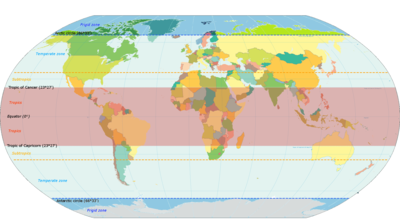

| Part of a series on |
| Weather |
|---|
|
|
In geography, the temperate climates of Earth occur in the middle latitudes (approximately 23.5° to 66.5° N/S of Equator), which span between the tropics and the polar regions of Earth.[1] These zones generally have wider temperature ranges throughout the year and more distinct seasonal changes compared to tropical climates, where such variations are often small; they usually differ only in the amount of precipitation.[2]
In temperate climates, not only do latitudinal positions influence temperature changes, but various sea currents, prevailing wind direction, continentality (how large a landmass is) and altitude also shape temperate climates.[3]
The Köppen climate classification defines a climate as "temperate" C, when the mean temperature is above −3 °C (26.6 °F) but below 18 °C (64.4 °F) in the coldest month to account for the persistence of frost. However, some adaptations of Köppen set the minimum at 0 °C (32.0 °F). Continental climates are classified as D and considered to be varieties of temperate climates, having more extreme temperatures, with mean temperatures in the coldest month usually being below −3 °C (26.6 °F).
- ^ "Weather & Climate Change: Climates around the world". Education Scotland. Archived from the original on 14 April 2016.
- ^ Society, National Geographic (21 January 2011). "tropics". National Geographic Society. Retrieved 27 March 2022.
- ^ "What Are the Forty Factors That Influence OurWeather?". Education – Seattle PI. 19 December 2013. Retrieved 27 March 2022.